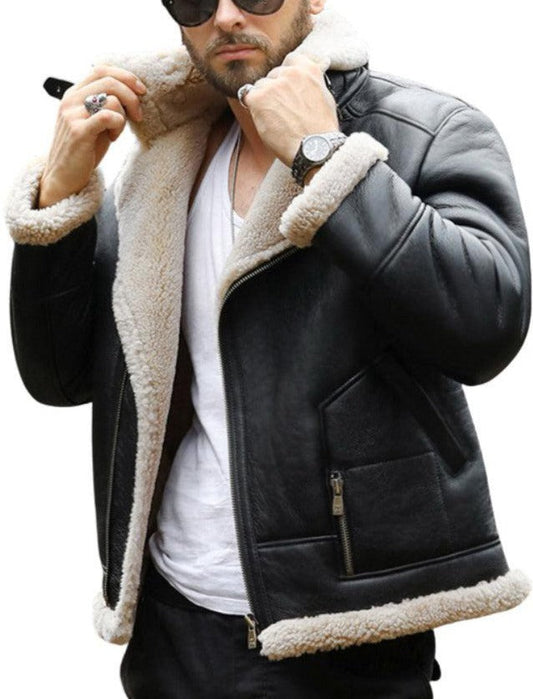Different Types of Leather for Jackets

A leather jacket can be your lifetime investment and the perfect addition to your wardrobe. From stylish bomber leather jackets to vintage classic jackets, every jacket offers a unique, elegant, and modish look to a wearer. Therefore, that lifetime investment demands your laser focus while purchasing. Apart from varying designs, different types of leather is one of the decisive yet ignored factors that may get your wires crossed. All kinds of leather for jackets, ostensibly, seem alike, but you will observe differences in comparing durability, strength, stretching, weight, insulation, softness, and comfort. For instance, cowhide leather is more resilient, tougher, harder, and heavier than goatskin leather. Apart from the animal-based leather category, we can have other categories based on animal skin layers. In fact, it is safe to say that one needs to research rigorously before buying a leather jacket.
Amrika Leather is here to assist buyers in knowing different kinds of leather for jackets, thereby, you can make a wiser decision. Let's take a trip to different types of leather for jackets.
Different types of leather for jackets:
Mainly, we can categorize leather-based on the following factors;
- Animal-based leather types
- Animal Skin layer based Leather type
- Finishing based leather types
Let's have a look at all the categories of leather types one by one;
Animal-based leather types:
When we start analyzing different types of leather, acquired from different animals, we will have hundreds of leather types. However, here we are going to discuss the popular ones; cowhide, sheepskin, goatskin, and lambskin.
While analyzing, we are considering the following factors to rate any leather;
- Strength
- Stretchability
- Weight
- Insulation
- Comfort and softness
Cowhide:
Cowhide leather is one of the most popular and easily accessible types. While comparing all the factors mentioned above, we can clearly see that no other cowhide counterpart can compete with it regarding strength and insulation. It is robust and sturdy, which turns it into long-lasting leather.
Apart from strength, the stretchability of cowhide leather may disappoint you. Similarly, cowhide leather is weightier and less comfy than other type of leather.
For the features mentioned above, cowhide can be a perfect choice for biker leather jackets.
Sheepskin:
Similar to cowhide leather, sheepskin leather also comes with various feathers in its cap. For example, sheepskin leather wins the battle when we compare its stretchability, weight, softness, and comfort. Therefore, if you are in search of some comfier lightweight leather jackets, sheepskin leather jackets can put a full stop to your search.
Apart from comfort and stretchability, sheepskin leather is a delicate item more prone to getting damaged by sharp items. You may feel no difference between the insulation of cowhide leather and sheepskin leather.
Goatskin Leather:
By reading about sheepskin and cowhide leather, you now have a clear idea of both strengths and limitations. Therefore, if you want leather featuring between sheepskin and cowhide, goatskin leather is made for you.
For example, cowhide is resilient and robust but weightier and less comfy. Similarly, sheepskin leather is stretchable, comfier, and soft but lags in durability.
Here, goatskin leather comes in. It is more durable than sheepskin, comfier, softer, and lighter than cowhide leather.
Therefore, you should choose goatskin leather for a durable, comfier, smooth, and better insulation experience.
Lambskin Leather:
Lambskin leather is a relatively softer, lighter, and more comfortable option than its counterparts. The feature that puts lambskin leather above par is it's lightweight.
The only negative side of lambskin leather is its small size, which makes it hard to manufacture large leather items from lambskin leather.
Sourcing layer-based leather types:
An animal hide/skin comprises three layers;
- The Grain (outermost layer)
- The Corium (Middle layer)
- The Flesh Layer (innermost)
Different types of leather can be obtained from the mentioned skin layers. Here, we can categorize different types of leather-based on hide/skin layers.
Full-Grain Leather:
Full-grain leather is obtained from the outermost skin layer called "the grain". Removing hair from the outermost layer involves some basic processes that prepare it for jacket manufacturing.
No sanding or buffing technique is used to remove any imperfections or natural stains from the skin; that's why it comes in a natural look.
As we have described earlier, full-grain leather is sourced from the outer layer, so it tends to be more robust.
Top-Grain Leather:
In simpler words, we can say that top-grain leather is a refined form of full-grain leather. Top-grain leather is treated with rigorous sanding and buffing techniques. So, you won't find any imperfection or irregularity in top-grain leather.
You may get a more refined and shiny top-grain leather; however, this leather type has compromised water-resistant quality and strength.
Genuine Leather:
Genuine leather is generally confused with real leather. Genuine leather is also real leather. However, genuine leather is technically used for leather sourced from any hidden layer. The other name of genuine leather is corrected leather.
This type of leather is treated with sanding and buffing. Moreover, dyeing and spraying are also included in genuine leather.
Bonded Leather:
Bonded leather has nothing to do with sourcing layers. In fact, bonded leather is obtained from small pieces of shredded and waste leather.
Polyurethane or some other chemicals are used to manufacture a large piece of bonded leather.
Some other types of leather for jackets:
Apart from animal-based and sourcing-layer-based leather types, there are also several other types. For example,
- Aniline leather
- Semi-Aniline leather
- Pigmented leather
- Split leather
- Suede leather
- Nubuck leather
Conclusion:
We know it is a relatively complex subject to understand the types of leather used for jackets, as all types seem similar. However, minor differences make substantial changes. Therefore, it is advised to research before investing in a leather jacket. If you have any other related queries, please ask in the comment section, and Amrika Leather experts will answer them.
No comments
- Choosing a selection results in a full page refresh.






















comments